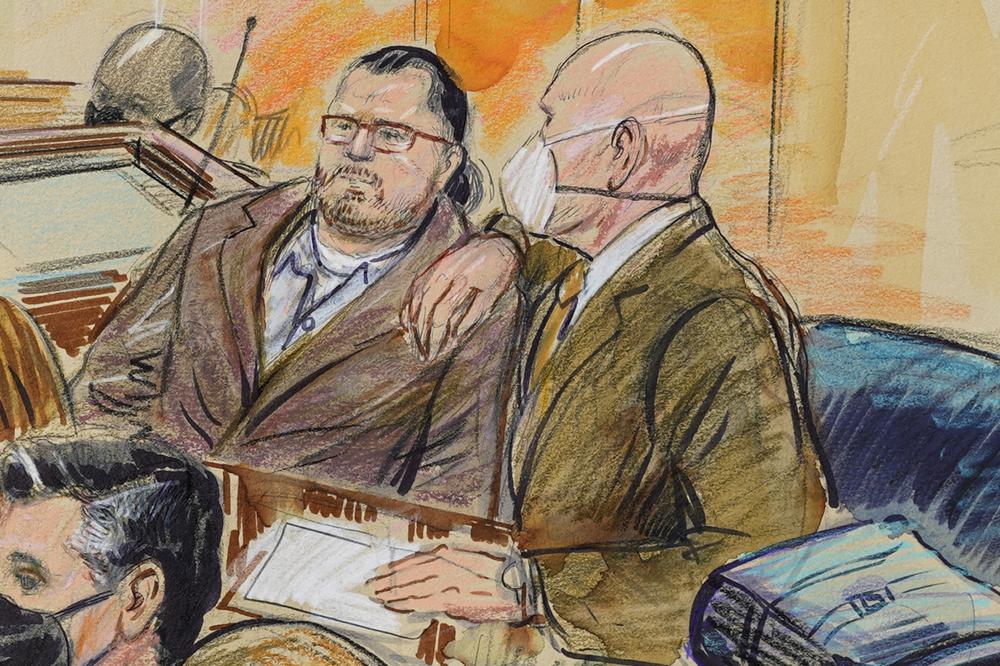First trial in Capitol riot ends in conviction on all counts

A Texas man was convicted on Tuesday of storming the U.S. Capitol with a holstered handgun, a milestone victory for federal prosecutors in the first trial among hundreds of cases arising from last year’s riot. A jury also convicted Guy Wesley Reffitt of obstructing Congress’ joint session to certify the Electoral College vote on January 6, 2021, of interfering with police officers who were guarding the Capitol and of threatening his two teenage children if they reported him to law enforcement after the attack. Jurors deliberated about three hours and convicted him on all counts. The verdict could be a bellwether for many other Capitol riot cases. It could give Justice Department prosecutors more leverage in plea negotiations and discourage other defendants from gambling on trials of their own. Gregg Sofer, a former federal prosecutor who served as U.S. attorney for the Western District of Texas from October 2020 to February 2021, said before Reffitt’s trial started that it would be “the canary in the coal mine.” “If you’re a defendant awaiting trial at this point, the canary just died,” said Sofer, now a partner at the law firm Husch Blackwell. “I do think it is likely to affect people’s perceptions about the likelihood of their success.” Reffitt, 49, of Wylie, Texas, didn’t testify at his trial, which started last Wednesday. He showed little visible reaction to the verdict, but his face was covered by a mask. Outside court, his wife Nicole said the verdict was “against all American people. If you’re going to be convicted on your First Amendment rights, all Americans should be wary. This fight has just begun.” She said her husband was being used as an example by the government. “You are all in danger,” she said. In a statement after the verdict, U.S. Attorney Matthew Graves in Washington thanked the jury “for upholding the rule of law and for its diligent service in this case.” During the trial’s closing arguments on Monday, Assistant U.S. Attorney Risa Berkower told jurors that Reffitt drove to Washington, D.C., intending to stop Congress from certifying President Joe Biden’s electoral victory. Reffitt proudly “lit the fire” that allowed others in a mob to overwhelm Capitol police officers near the Senate doors, the prosecutor said. Reffitt was not accused of entering the Capitol building. Defense attorney William Welch said there is no evidence that Reffitt damaged property, used force, or physically harmed anybody. He will be sentenced on June 8. He could receive 20 years in prison on the top charge alone, but he’s likely to face far less time behind bars. Other rioters have pleaded guilty; the longest sentence so far is five years and three months for Robert Palmer, a Florida man who pleaded guilty to attacking police officers at the Capitol. The riot resulted in the deaths of five people, including a police officer. More than 100 officers were injured. Rioters caused over $1 million in damage to the Capitol. U.S. District Judge Dabney Friedrich presided over Reffitt’s trial. Donald Trump nominated her in 2017. Welch has said Reffitt worked as a rig manager and as a consultant in the petroleum industry before COVID-19 restrictions effectively shut down his business. Jurors saw videos that captured the confrontation between a few Capitol police officers and a mob of people, including Reffitt, who approached them on the west side of the Capitol. Reffitt was armed with a Smith & Wesson pistol in a holster on his waist, carrying zip-tie handcuffs and wearing body armor and a helmet equipped with a video camera when he advanced on police, according to prosecutors. He retreated after an officer pepper sprayed him in the face, but he waved on other rioters who ultimately breached the building, prosecutors said. Before the crowd advanced, Reffitt used a megaphone to shout at police to step aside and to urge the mob to push forward and overtake officers. Assistant U.S. Attorney Jeffrey Nestler said Reffitt played a leadership role that day. During last Friday’s testimony, prosecutors zoomed in on a video image of Reffitt at the Capitol. FBI Special Agent Laird Hightower said the image shows “a silvery metallic linear object” in a holster protruding from under Reffitt’s jacket as he leaned forward. Shauni Kerkhoff, who was one of the Capitol police officers who tried to repel Reffitt, said she launched pepper balls that didn’t stop him from advancing. She testified that Reffitt appeared to be leading the crowd upstairs toward police. Reffitt’s 19-year-old son, Jackson, testified last Thursday that his father threatened him and his sister, then 16, after he drove home from Washington. Reffitt told his children they would be traitors if they reported him to authorities and said, “traitors get shot,” Jackson Reffitt recalled. He said the threat terrified him. His younger sister, Peyton, was listed as a possible government witness but didn’t testify. She said that she would talk more later on her own time, but: “Kids should never be used against the parents.” Jackson Reffitt used a cellphone app to secretly record his father boasting about his role in the riot. Jurors heard excerpts of that family conversation. Jackson Reffitt initially contacted the FBI on Christmas Eve, less than two weeks before the riot, to report concerns about his father’s behavior and increasingly worrisome rhetoric. But the FBI didn’t respond until January 6, after the riot erupted. Another key witness, Rocky Hardie, said he and Reffitt were members of the “Texas Three Percenters” militia group. The Three Percenters militia movement refers to the myth that only 3% of Americans fought in the Revolutionary War against the British. Hardie drove from Texas to Washington with Reffitt. He testified that both of them were armed with holstered handguns when they attended then-President Donald Trump’s “Stop the Steal” rally before the riot erupted. Reffitt also took an AR-15 rifle to Washington but left it locked up in his car, Hardie said. Hardie said Reffitt talked about dragging lawmakers out of the Capitol and replacing them with people who
Alabama Oath Keeper pleads guilty to seditious conspiracy in January 6 riot

An Alabama man affiliated with the far-right Oath Keepers militia group pleaded guilty Wednesday to seditious conspiracy for his actions leading up and through the January 6 riot, marking the first person involved in the violent attack on the U.S. Capitol to be convicted of the rarely used charge. The sentencing guideline range for Joshua A. James, who also pleaded guilty to a charge of obstruction of an official proceeding, was estimated to be 7¼ to nine years in prison. The 34-year-old from Arab, Alabama, acknowledged getting into a physical altercation with a police officer while inside the Capitol and participating in a plan to use force to hinder or delay the transfer of presidential power. James also agreed to cooperate with authorities investigating the riot, including testifying before a grand jury. Authorities say James and others affiliated with the group rode golf carts to the Capitol, moved through the crowd in a military-style “stack” formation, and went into the building. James was accused of pushing past officers who tried to stop rioters from moving toward the Rotunda, joining others who confronted officers and profanely proclaiming the building was his. A week before the riot, James said in an encrypted chat that he believed teams within the militia group were adequately armed, prosecutors said in court records. While four other people connected with the Oath Keepers have pleaded guilty to obstruction of Congress and a lesser conspiracy charge, James is the first among the 11 people associated with the group to plead guilty to a seditious conspiracy charge. The seditious conspiracy prosecution is the boldest publicly known attempt so far by the government to prosecute those who attacked the U.S. Capitol. The group’s founder, Stewart Rhodes, and others have pleaded not guilty to seditious conspiracy and other charges. A seditious conspiracy conviction carries a maximum penalty of 20 years, compared with five years on the lesser conspiracy charge facing other group members. Those charged with seditious conspiracy are accused of working together to use force to stop the peaceful transfer of presidential power. Authorities say participants discussed their plans in encrypted chats, traveled to the nation’s capital from across the country, organized into teams, used military tactics, stashed weapons in case they felt they were needed, and communicated with each other during the riot on January 6, 2021. Prosecutors say the group set up a “quick reaction force,” or QRF, that kept guns at a hotel in nearby Arlington, Virginia, and were prepared to bring the weapons into Washington if Rhodes or associates believed the need arose. Days before the attack, one defendant suggested getting a boat to ferry weapons across the Potomac River. In the end, the QRF teams didn’t bring guns into Washington. At the Capitol, Oath Keepers marched in two teams in stack formation, with team members advancing forward with one hand on the shoulder of the person in front of them. More than 750 people have been charged with federal crimes related to the riot. Over 220 riot defendants have pleaded guilty, more than 100 have been sentenced, and at least 90 others have trial dates. The longest prison sentence handed down so far to a January 6 rioter was given to Robert Palmer of Largo, Florida. Palmer, who was sentenced to 5-1/2 years in prison, acknowledged hurling a wooden plank at officers protecting a Capitol entrance, spraying a fire extinguisher, then throwing it when it was done. Republished with the permission of the Associated Press.


